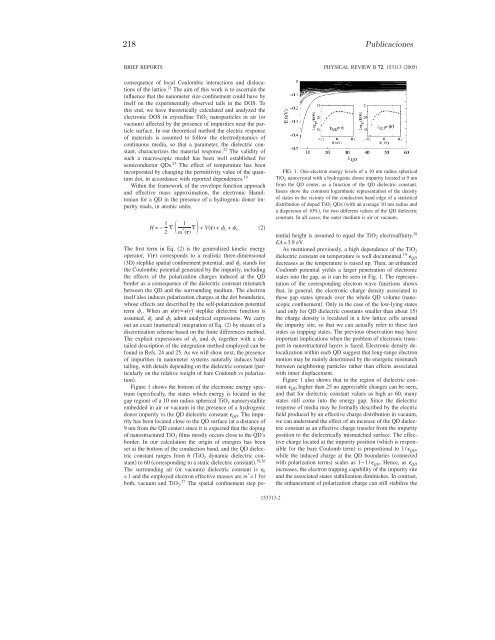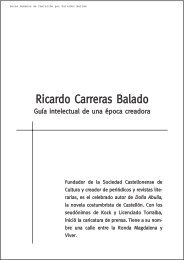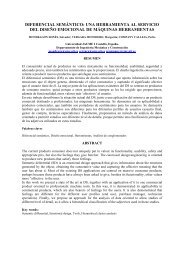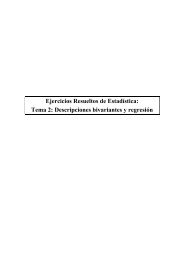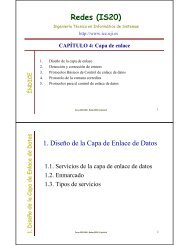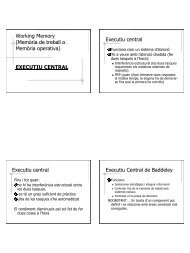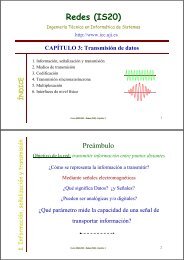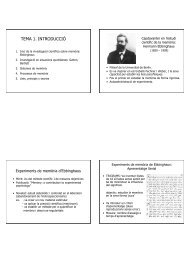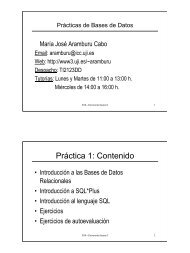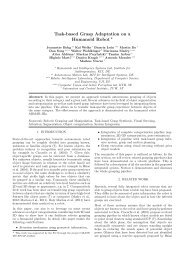218 PublicacionesBRIEF REPORTSconsequence of local Coulombic interactions and dislocationsof the lattice. 21 The aim of this work is to ascertain theinfluence that the nanometer size confinement could have byitself on the experimentally observed tails in the DOS. Tothis end, we have theoretically calculated and analyzed theelectronic DOS in crystalline TiO 2 nanoparticles in air orvacuum affected by the presence of impurities near the particlesurface. In our theoretical method the electric responseof materials is assumed to follow the electrodynamics ofcontinuous media, so that a parameter, the dielectric constant,characterizes the material response. 22 The validity ofsuch a macroscopic model has been well established forsemiconductor QDs. 23 The effect of temperature has beenincorporated by changing the permittivity value of the quantumdot, in accordance with reported dependences. 19Within the framework of the envelope function approachand effective mass approximation, the electronic Hamiltonianfor a QD in the presence of a hydrogenic donor impurityreads, in atomic units,H =− 1 2 1m * r + Vr + c + s .2PHYSICAL REVIEW B 72, 153313 2005FIG. 1. One-electron energy levels of a 10 nm radius sphericalTiO 2 nanocrystal with a hydrogenic donor impurity located at 9 nmfrom the QD center, as a function of the QD dielectric constant.Insets show the common logarithmic representation of the densityof states in the vicinity of the conduction band edge of a statisticaldistribution of doped TiO 2 QDs with an average 10 nm radius anda dispersion of 10%, for two different values of the QD dielectricconstant. In all cases, the outer medium is air or vacuum.The first term in Eq. 2 is the generalized kinetic energyoperator, Vr corresponds to a realistic three-dimensional3D steplike spatial confinement potential, and c stands forthe Coulombic potential generated by the impurity, includingthe effects of the polarization charges induced at the QDborder as a consequence of the dielectric constant mismatchbetween the QD and the surrounding medium. The electronitself also induces polarization charges at the dot boundaries,whose effects are described by the self-polarization potentialterm s . When an r=r steplike dielectric function isassumed, c and s admit analytical expressions. We carryout an exact numerical integration of Eq. 2 by means of adiscretization scheme based on the finite differences method.The explicit expressions of c and s together with a detaileddescription of the integration method employed can befound in Refs. 24 and 25. As we will show next, the presenceof impurities in nanometer systems naturally induces bandtailing, with details depending on the dielectric constant particularlyon the relative weight of bare Coulomb vs polarization.Figure 1 shows the bottom of the electronic energy spectrumspecifically, the states which energy is located in thegap region of a 10 nm radius spherical TiO 2 nanocrystalliteembedded in air or vacuum in the presence of a hydrogenicdonor impurity vs the QD dielectric constant QD . The impurityhas been located close to the QD surface at a distance of9 nm from the QD center since it is expected that the dopingof nanostructured TiO 2 films mostly occurs close to the QD’sborder. In our calculation the origin of energies has beenset at the bottom of the conduction band, and the QD dielectricconstant ranges from 6 TiO 2 dynamic dielectric constantto 60 corresponding to a static dielectric constant. 19,26The surrounding air or vacuum dielectric constant is 0=1 and the employed electron effective masses are m * =1 forboth, vacuum and TiO 2 . 27 The spatial confinement step potentialheight is assumed to equal the TiO 2 electroaffinity, 28EA=3.9 eV.As mentioned previously, a high dependence of the TiO 2dielectric constant on temperature is well documented. 19 QDdecreases as the temperature is raised up. Then, an enhancedCoulomb potential yields a larger penetration of electronicstates into the gap, as it can be seen in Fig. 1. The representationof the corresponding electron wave functions showsthat, in general, the electronic charge density associated tothese gap states spreads over the whole QD volume nanoscopicconfinement. Only in the case of the low-lying statesand only for QD dielectric constants smaller than about 15the charge density is localized in a few lattice cells aroundthe impurity site, so that we can actually refer to these laststates as trapping states. The previous observation may haveimportant implications when the problem of electronic transportin nanostructured layers is faced. Electronic density delocalizationwithin each QD suggest that long-range electronmotion may be mainly determined by the energetic mismatchbetween neighboring particles rather than effects associatedwith inner displacement.Figure 1 also shows that in the region of dielectric constant QD higher than 25 no appreciable changes can be seen,and that for dielectric constant values as high as 60, manystates still come into the energy gap. Since the dielectricresponse of media may be formally described by the electricfield produced by an effective charge distribution in vacuum,we can understand the effect of an increase of the QD dielectricconstant as an effective charge transfer from the impurityposition to the dielectrically mismatched surface. The effectivecharge located at the impurity position which is responsiblefor the bare Coulomb term is proportional to 1/ QD ,while the induced charge at the QD boundaries connectedwith polarization terms scales as 1−1/ QD . Hence, as QDincreases, the electron trapping capability of the impurity siteand the associated states stabilization diminishes. In contrast,the enhancement of polarization charge can still stabilize the153313-2
Confinamiento dieléctrico 219BRIEF REPORTSstates pushing them into the energy gap. <strong>It</strong> is worth notingout that as the polarization charge is distributed over thewhole QD surface, the polarization-induced gap states arespread over the whole QD volume and not trapped in thesurroundings of the impurity site.The different penetration of the electronic states into thegap is also reflected in the DOS profile. Insets in Fig. 1 showthe calculated DOS for QD =6 that would correspond tohigh temperature, left panel and for QD =60 low temperature,right panel. 29 We have assumed in these calculations astatistical distribution of QDs with an average 10 nm radiusand a 10% dispersion, usual values for technological materials.Insets in Fig. 1 show that the calculated DOS profiles donot fit an exponential law Eq. 1. However, it resemblesthe experimentally observed DOS near the conduction bandlower edge. 7The exponential model, Eq. 1, allows characterizing theDOS profile by means of a constant parameter E 0 , inverselyproportional to the slope of the logarithmic representation ofthe DOS. However, in our calculations it is not a constant butdepends on energy. We can observe, though, that the inverseof the mentioned slope increases with temperature at anyenergy value in the gap see insets in Fig. 1. This agreesqualitatively with the increment of E 0 with temperaturefound in literature in case of QDs in air or vacuum. 18 Thenumber of states in the gap, as it can be inferred from data ininsets of Fig. 1, is of the same order as the experimentallydetermined. 7PHYSICAL REVIEW B 72, 153313 2005Both insets show a maximum in the DOS, approximatelylocated in the bottom of the conduction band. <strong>It</strong> is the resultof the interplay of two different sources of confinement,namely, the QD spatial confinement potential and the Coulombicpotentials. The deepest states in the gap are the mostinfluenced by the Coulomb terms, providing a DOS whichincreases with energy. However, for highly excited stateswhere the spatial confinement is most relevant, the situationis reversed: DOS decreases with energy. The energy domaincharacterized by the DOS maximum could be referred to as atransition region between these two regimes.Summing up, Coulomb terms bare Coulomb and surfacepolarization may explain the presence of states in the energygap, as derived from impurity doping in semiconductornanostructures. They also predict a dependence of the DOSon temperature. We have proven that in addition to wellknownexplanations for band tailing in bulk semiconductorslocal Coulombic interactions and lattice dislocation the nanometersize confinements are able to induce similar effects.Moreover, our approach predicts a high degree of electronicdensity delocalization within the QD, which has importantimplications on developing transport models.Financial support from MEC-DGI Project No. CTQ2004-02315/BQU and UJI-Bancaixa Project No. P1-B2002-01 isgratefully acknowledged. A MECD of Spain FPU grant isalso acknowledged JLM.*Electronic address: garciag@uji.es1 P. Guyot-Sionnest, M. Shim, C. Matranga, and M. Hines, Phys.Rev. B 60, R2181 1999.2 I. N. Hulea, H. B. Brom, A. J. Houtepen, D. Vanmaekelbergh, J.J. Kelly, and E. A. Meulenkamp, Phys. Rev. Lett. 93, 1666012004.3 A. L. Roest, J. J. Kelly, D. Vanmaekelbergh, and E. A. Meulenkamp,Phys. Rev. Lett. 89, 036801 2002.4 D. Yu, C. Wang, and P. Guyot-Sionnest, Science 300, 12772003.5 J. Bisquert, D. Cahen, G. Hodes, S. Rhle, and A. Zaban, J. Phys.Chem. B 108, 8106 2004.6 R. Konenkamp, Phys. Rev. B 61, 11057 2000.7 V. G. Kytin, J. Bisquert, I. Abayev, and A. Zaban, Phys. Rev. B70, 193304 2004.8 F. Fabregat-Santiago, I. Mora-Seró, G. Garcia-Belmonte, and J.Bisquert, J. Phys. Chem. B 107, 758 2003.9 L. M. Peter, N. W. Duffy, R. L. Wang, and K. G. U. Wijayantha,J. Electroanal. Chem. 524-525, 127 2002.10 H. Wang, J. He, G. Boschloo, H. Lindstrm, A. Hagfeldt, and S.Lindquist, J. Phys. Chem. B 105, 2529 2001.11 J. Bisquert, G. Garcia-Belmonte, and J. Garcáa-Cañadas, J. Appl.Phys. 120, 6726 2004.12 J. Bisquert, A. Zaban, M. Greenshtein, and I. Mora-Seró, J. Am.Chem. Soc. 126, 13550 2004.13 L. Dloczik, O. Ileperuma, I. Lauerman, L. M. Peter, E. A. Ponomarev,G. Redmond, N. J. Shaw, and I. Uhlendorf, J. Phys.Chem. B 101, 10281 1997.14 J. van de Lagemaat and A. J. Frank, J. Phys. Chem. B 105, 111942001.15 A. Kambili, A. B. Walker, F. L. Qiu, A. C. Fisher, A. D. Savin,and L. M. Peter, Physica E Amsterdam 14, 203 2002.16 J. van de Lagemaat and A. J. Frank, J. Phys. Chem. B 104, 42922000.17 N. Kopidakis, K. D. Benkstein, J. van de Lagemaat, and A. J.Frank, J. Phys. Chem. B 107, 11307 2003.18 T. Dittrich, Phys. Status Solidi A 182, 447 2000.19 R. A. Parker, Phys. Rev. 124, 1719 1961.20 J. I. Pankove, Optical Processes in Semiconductors Prentice-Hall, Englewood Cliffs, NJ, 1971.21 A. Iribarren, R. Castro-Rodríguez, V. Sosa, and J. L. Peña, Phys.Rev. B 60, 4758 1999.22 For this reason, we have not included in this study nanoporousfilms permeated with aqueous electrolyte solutions, as these solutionsin nanocavities should probably require a different discretelikemodeling, and then comparison on a common footwould not be possible.23 P. G. Bolcatto and C. R. Proetto, J. Phys.: Condens. Matter 13,319 2001; L. Bányai and S. W. Koch, Semiconductor QuantumDots Word Scientific, Singapore, 1993.24 J. L. Movilla and J. Planelles, Comput. Phys. Commun. 170, 1442005.25 J. L. Movilla and J. Planelles, Phys. Rev. B 71, 075319 2005.26 M. Mikami, S. Nakamura, O. Kitao, and H. Arakawa, Phys. Rev.153313-3
- Page 1:
CONFINAMIENTO NANOSCÓPICO ENESTRUC
- Page 5 and 6:
AgradecimientosDecía Albert Einste
- Page 7:
A mi madreA la memoria de mi padre
- Page 10 and 11:
viiihigh-correlation electronic reg
- Page 12 and 13:
xric) resolution method proves the
- Page 14 and 15:
xii14. F. Rajadell, J.L. Movilla, M
- Page 16 and 17:
xivcen para moldear a voluntad su e
- Page 18 and 19:
xvideterminar las características
- Page 23 and 24:
Capítulo 1Fundamentos teóricosEl
- Page 25 and 26:
1.1 Modelo k · p 3donde p = −i¯
- Page 27 and 28:
1.1 Modelo k · p 5inversa de la ma
- Page 29 and 30:
1.2 Heteroestructuras. Aproximació
- Page 31 and 32:
1.3 Masa efectiva dependiente de la
- Page 33 and 34:
1.4 Aplicación de un campo magnét
- Page 35 and 36:
1.5 Potenciales monopartícula adic
- Page 37 and 38:
1.6 Integración numérica del hami
- Page 39 and 40:
1.7 Transiciones intrabanda 17Tras
- Page 41 and 42:
1.7 Transiciones intrabanda 19g) [7
- Page 43 and 44:
Capítulo 2Confinamientos espacial
- Page 45 and 46:
23esta aproximación asume implíci
- Page 47 and 48:
2.1 Puntos cuánticos de InAs en ma
- Page 49 and 50:
2.1 Puntos cuánticos de InAs en ma
- Page 51 and 52:
2.1 Puntos cuánticos de InAs en ma
- Page 53 and 54:
2.1 Puntos cuánticos de InAs en ma
- Page 55 and 56:
Capítulo 3Confinamiento periódico
- Page 57 and 58:
3.1 Funciones de Wannier 35otro con
- Page 59 and 60:
3.1 Funciones de Wannier 373.1.1. F
- Page 61 and 62:
3.2 Evolución temporal en modelos
- Page 63 and 64:
3.2 Evolución temporal en modelos
- Page 65 and 66:
3.2 Evolución temporal en modelos
- Page 67 and 68:
3.3 Tiempo de tunneling en cadenas
- Page 69 and 70:
3.3 Tiempo de tunneling en cadenas
- Page 71 and 72:
Capítulo 4Confinamiento magnético
- Page 73 and 74:
51donde m ∗ es la masa efectiva d
- Page 75 and 76:
4.1 Magnetización de puntos y anil
- Page 77 and 78:
4.1 Magnetización de puntos y anil
- Page 79 and 80:
4.1 Magnetización de puntos y anil
- Page 81 and 82:
4.2 Acoplamiento lateral de anillos
- Page 83 and 84:
4.2 Acoplamiento lateral de anillos
- Page 85 and 86:
4.2 Acoplamiento lateral de anillos
- Page 87 and 88:
4.2 Acoplamiento lateral de anillos
- Page 89 and 90:
Capítulo 5Confinamiento dieléctri
- Page 91 and 92:
69Más complicado pero también ana
- Page 93 and 94:
5.1 Validez de la electrodinámica
- Page 95 and 96:
5.2 Interacciones culómbicas en pu
- Page 97 and 98:
5.2 Interacciones culómbicas en pu
- Page 99 and 100:
5.3 Barreras confinantes finitas e
- Page 101 and 102:
5.3 Barreras confinantes finitas e
- Page 103 and 104:
5.3 Barreras confinantes finitas e
- Page 105 and 106:
5.3 Barreras confinantes finitas e
- Page 107 and 108:
5.4 Impurezas dadoras hidrogenoides
- Page 109 and 110:
5.4 Impurezas dadoras hidrogenoides
- Page 111 and 112:
5.4 Impurezas dadoras hidrogenoides
- Page 113 and 114:
5.4 Impurezas dadoras hidrogenoides
- Page 115 and 116:
5.4 Impurezas dadoras hidrogenoides
- Page 117 and 118:
5.4 Impurezas dadoras hidrogenoides
- Page 119 and 120:
5.4 Impurezas dadoras hidrogenoides
- Page 121 and 122:
5.4 Impurezas dadoras hidrogenoides
- Page 123 and 124:
5.4 Impurezas dadoras hidrogenoides
- Page 125 and 126:
5.4 Impurezas dadoras hidrogenoides
- Page 127 and 128:
5.4 Impurezas dadoras hidrogenoides
- Page 129 and 130:
5.5 Estados superficiales inducidos
- Page 131 and 132:
5.5 Estados superficiales inducidos
- Page 133 and 134:
5.5 Estados superficiales inducidos
- Page 135 and 136:
5.5 Estados superficiales inducidos
- Page 137 and 138:
5.5 Estados superficiales inducidos
- Page 139 and 140:
5.5 Estados superficiales inducidos
- Page 141 and 142:
5.5 Estados superficiales inducidos
- Page 143 and 144:
5.5 Estados superficiales inducidos
- Page 145 and 146:
5.5 Estados superficiales inducidos
- Page 147 and 148:
5.5 Estados superficiales inducidos
- Page 149 and 150:
5.5 Estados superficiales inducidos
- Page 151 and 152:
5.5 Estados superficiales inducidos
- Page 153 and 154:
5.5 Estados superficiales inducidos
- Page 155 and 156:
5.5 Estados superficiales inducidos
- Page 157 and 158:
5.5 Estados superficiales inducidos
- Page 159 and 160:
5.5 Estados superficiales inducidos
- Page 161 and 162:
5.5 Estados superficiales inducidos
- Page 163 and 164:
5.5 Estados superficiales inducidos
- Page 165 and 166:
5.5 Estados superficiales inducidos
- Page 167 and 168:
5.5 Estados superficiales inducidos
- Page 169 and 170:
5.5 Estados superficiales inducidos
- Page 171 and 172:
5.5 Estados superficiales inducidos
- Page 173 and 174:
5.5 Estados superficiales inducidos
- Page 175 and 176:
Capítulo 6ConclusionesEn esta Tesi
- Page 177 and 178:
155entre los anillos como la orient
- Page 179 and 180:
157fuerte decaimiento de la intensi
- Page 181 and 182:
Publicaciones
- Page 183 and 184:
Confinamientos espacial y másico
- Page 185 and 186:
Confinamientos espacial y másico 1
- Page 187 and 188:
Confinamientos espacial y másico 1
- Page 189 and 190: Confinamientos espacial y másico 1
- Page 191 and 192: Confinamiento periódico
- Page 193 and 194: Confinamiento periódico 171J. Phys
- Page 195 and 196: Confinamiento periódico 173Tunneli
- Page 197 and 198: Confinamiento periódico 175Tunneli
- Page 199 and 200: Confinamiento magnético
- Page 201 and 202: Confinamiento magnético 179Symmetr
- Page 203 and 204: Confinamiento magnético 181Aharono
- Page 205 and 206: Confinamiento magnético 183Aharono
- Page 207 and 208: Confinamiento magnético 185Aharono
- Page 209 and 210: Confinamiento magnético 187PHYSICA
- Page 211 and 212: Confinamiento magnético 189MAGNETI
- Page 213 and 214: Confinamiento magnético 191IOP Pub
- Page 215 and 216: Confinamiento magnético 193938Mean
- Page 217 and 218: Confinamiento magnético 195940QRs
- Page 219 and 220: Confinamiento dieléctrico
- Page 221 and 222: Confinamiento dieléctrico 199Compu
- Page 223 and 224: Confinamiento dieléctrico 201146 J
- Page 225 and 226: Confinamiento dieléctrico 203148 J
- Page 227 and 228: Confinamiento dieléctrico 205150 J
- Page 229 and 230: Confinamiento dieléctrico 207152 J
- Page 231 and 232: Confinamiento dieléctrico 209PHYSI
- Page 233 and 234: Confinamiento dieléctrico 211OFF-C
- Page 235 and 236: Confinamiento dieléctrico 213OFF-C
- Page 237 and 238: Confinamiento dieléctrico 215OFF-C
- Page 239: Confinamiento dieléctrico 217PHYSI
- Page 243 and 244: Confinamiento dieléctrico 221PHYSI
- Page 245 and 246: Confinamiento dieléctrico 223TRAPP
- Page 247 and 248: Confinamiento dieléctrico 225Deloc
- Page 249 and 250: Confinamiento dieléctrico 227V s (
- Page 251 and 252: Confinamiento dieléctrico 229with
- Page 253 and 254: Confinamiento dieléctrico 231value
- Page 255 and 256: Confinamiento dieléctrico 233(R in
- Page 257 and 258: Confinamiento dieléctrico 23525R i
- Page 259 and 260: Confinamiento dieléctrico 237monoe
- Page 261 and 262: Confinamiento dieléctrico 239[8] Y
- Page 263 and 264: Confinamiento dieléctrico 241[48]
- Page 265 and 266: Confinamiento dieléctrico 243PHYSI
- Page 267 and 268: Confinamiento dieléctrico 245FROM
- Page 269 and 270: Confinamiento dieléctrico 247PHYSI
- Page 271 and 272: Confinamiento dieléctrico 249THEOR
- Page 273 and 274: Confinamiento dieléctrico 251THEOR
- Page 275 and 276: Confinamiento dieléctrico 253PHYSI
- Page 277 and 278: Confinamiento dieléctrico 255DIELE
- Page 279 and 280: Confinamiento dieléctrico 257DIELE
- Page 281 and 282: Confinamiento dieléctrico 259DIELE
- Page 283 and 284: Confinamiento dieléctrico 261DIELE
- Page 285 and 286: Confinamiento dieléctrico 263PHYSI
- Page 287 and 288: Confinamiento dieléctrico 265FAR-I
- Page 289 and 290: Confinamiento dieléctrico 267FAR-I
- Page 291 and 292:
Confinamiento dieléctrico 269Diele
- Page 293 and 294:
Confinamiento dieléctrico 271Diele
- Page 295 and 296:
Confinamiento dieléctrico 273Diele
- Page 297 and 298:
Confinamiento dieléctrico 275Diele
- Page 299 and 300:
Confinamiento dieléctrico 277Diele
- Page 301 and 302:
Confinamiento dieléctrico 279Diele
- Page 303 and 304:
Confinamiento dieléctrico 281Diele
- Page 305 and 306:
Confinamiento dieléctrico 283Diele
- Page 307 and 308:
Confinamiento dieléctrico 285Diele
- Page 309 and 310:
Confinamiento dieléctrico 287Diele
- Page 311 and 312:
Confinamiento dieléctrico 289Diele
- Page 313 and 314:
Confinamiento dieléctrico 291Diele
- Page 315 and 316:
Bibliografía[1] J. Karwowski,“In
- Page 317 and 318:
BIBLIOGRAFÍA 295[23] J.L. Movilla,
- Page 319 and 320:
BIBLIOGRAFÍA 297[48] M.G. Burt,
- Page 321 and 322:
BIBLIOGRAFÍA 299[71] W.H. Press, S
- Page 323 and 324:
BIBLIOGRAFÍA 301[97] U.H. Lee, D.
- Page 325 and 326:
BIBLIOGRAFÍA 303[121] S.W. Chung,
- Page 327 and 328:
BIBLIOGRAFÍA 305[145] R. Blossey y
- Page 329 and 330:
BIBLIOGRAFÍA 307[169] F. Suárez,
- Page 331 and 332:
BIBLIOGRAFÍA 309[194] C. Delerue,
- Page 333 and 334:
BIBLIOGRAFÍA 311[220] J.L. Zhu y X
- Page 335 and 336:
BIBLIOGRAFÍA 313[245] L.M. Peter,
- Page 337 and 338:
BIBLIOGRAFÍA 315[266] P. Rinke, K.
- Page 339 and 340:
BIBLIOGRAFÍA 317[289] Y. Wang, L.
- Page 341 and 342:
BIBLIOGRAFÍA 319[314] A. Wójs y P


